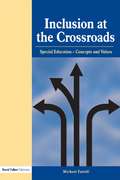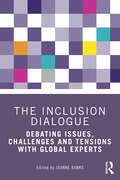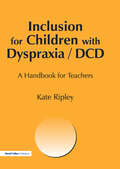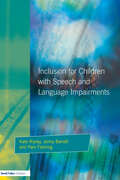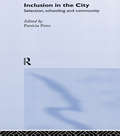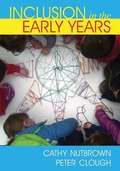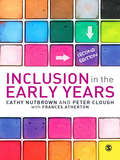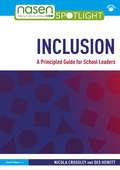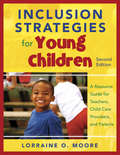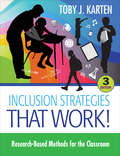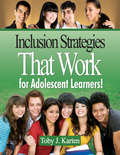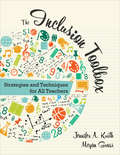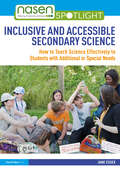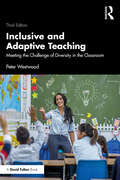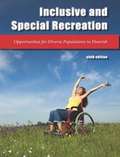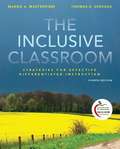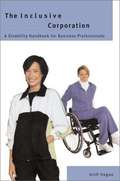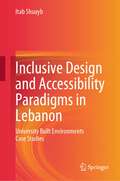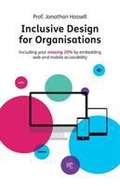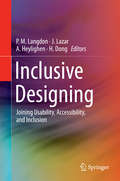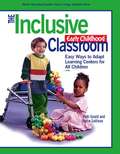- Table View
- List View
Inclusion at the Crossroads: Special Education--Concepts and Values
by Michael FarrellAnswering challenging questions such as "Does the term SEN mean anything any more?" and "Is SEN biologically or socially determined?" this book: * Makes sense of the controversy surrounding Special Educational Needs with clear sign posted information * Is comprehensive in the range of Special Educational Needs it covers * Clarifies information with case studies
The Inclusion Dialogue: Debating Issues, Challenges and Tensions with Global Experts
by Joanne BanksThe Inclusion Dialogue: Debating Issues, Challenges and Tensions with Global Experts brings together a series of global expert views on inclusive education, revealing the evolving tensions in this research area and highlighting future directions. Based on fascinating and unique conversations with leading academic experts across the globe, Joanne Banks uses in-depth interviews to examine current debates in special and inclusive education and provides a clear overview of the key tensions which impact policy and practice across different national contexts. Her book also highlights how inclusive education policies do not always translate into inclusive practices in our schools. The dialogue presented in this accessible text provides readers with insights into our conceptual understanding of inclusion within the context of the United Nations Convention on the Rights of People with Disabilities. Through these informal discussions, this book is ideal for academics and researchers working in the area of inclusive and special education, for educators wishing to create more inclusive environments for their students, and for policy-makers seeking to understand what inclusive education looks like on the ground.
Inclusion for Children with Dyspraxia: A Handbook for Teachers
by kate RipleyThis book is about children with dyspraxia: developmental co-ordination disorders (DCD) and what teachers and other professionals can do to promote their learning and their social inclusion in a mainstream setting. The author addresses issues which affect access to the curriculum in Key Stages 1-4 and offers strategies to support children which have proved effective to experienced practitioners and can be managed in a group or class context. A key component of the book is an understanding of the emotional and social needs of children with dyspraxia.
Inclusion For Children with Speech and Language Impairments: Accessing the Curriculum and Promoting Personal and Social Development (Resource Materials For Teachers Ser.)
by Kate Ripley Jenny Barrett Pam FlemingThis book is about children with speech and language impairments and what teachers and other professionals can do to promote their learning and their social inclusion in a mainstream setting. A brief introduction to SLI is followed by a chapter on the main issues for the classroom; how teachers can support the preferred learning style of the children and literacy and numeracy strategies are each given a separate section. Inclusion involves more than the learning experience and so the social, emotional and behavioral agenda, including successful transition and working with parents, is given equal emphasis.
Inclusion in the City: Selection, Schooling and Community
by Patricia PottsInclusion in the City explores inclusion and exclusion in the context of policy and practice in one English city - Birmingham. Here, a commitment to redressing the inequalities experienced by many learners has been inhibited by difficulty in securing agreement to a definite policy for inclusion and, consequently, in sustaining initiatives for strengthening participation in community comprehensive education.Grounded in an understanding of inclusion as a political and moral project, the book presents a range of perspectives from policymakers and practitioners. Detailed case studies, based on research specially undertaken for this book, relate inclusion to key issues in contemporary education such as; the effects of selection by attainment; faith schools and their communities; single sex education and inclusive schools; participation in further education; and social mobility.Insightful, thought provoking and original, Inclusion in the City detaches processes of inclusion and exclusion from the language of educational reform. In so doing it highlights links between participation in education and poverty, gender and cultural background, as well as the absence of a link between urban and educational renewal.
Inclusion in the Early Years
by Cathy Nutbrown Peter CloughIn this insightful text, the authors argue for a broad definition of inclusion, not limited to those with learning difficulties or impairment. The book presents a number of original stories generated from a recent research project carried out by the authors, and shows how to apply theory to practice. This new and revised edition includes an increased focus on: -Inclusion as a political issue -Social class -Poverty -Children's rights -The inclusion of gay and lesbian parents and staff -Practical activities including workshops and role-plays -Different policies around the UK This text is essential for all Early Years students, practitioners and researchers who want to become familiar with current research into inclusion and to develop ways of drawing on such studies to inform and develop their own inclusive practices. Cathy Nutbrown is Professor of Education and Director for Research at the University of Sheffield. Peter Clough is Honorary Professor of Education at the University of Sheffield Frances Atherton is Head of Department of Early Childhood Studies, at the University of Chester.
Inclusion in the Early Years: Critical Analyses And Enabling Narratives
by Cathy Nutbrown Peter Clough Frances AthertonThis insightful text shows how the attitudes of adults in early years settings can influence practice. The authors argue for a broad definition of inclusion, not limited to those with learning difficulties or impairment, but addressing factors affecting all members of the learning community. The book shows how the lives of practitioners, parents and children have been affected by inclusive and exclusionary practices. This new and revised edition includes an increased focus on: - inclusion as a political issue - social class - poverty - children's rights - gay and lesbian parents and staff This text is essential for all early years students, practitioners and researchers who want to become familiar with current research into inclusion and to develop ways of drawing on such studies to inform and devleop their own inclusive practices. Cathy Nutbrown is Professor of Education and Director for Research at the University of Sheffield. Peter Clough is Honorary Professor of Education at the University of Sheffield Frances Atherton is Head of Department of Early Childhood Studies, at the University of Chester.
Inclusion: A Principled Guide for School Leaders (nasen spotlight)
by Nicola Crossley Des HewittThis valuable and accessible guide navigates school leaders and those in training through a number of key areas of inclusion, providing context and understanding, helpful definitions, examples of leadership in action, and ten essential principles of inclusive leadership. Inclusion: A Principled Guide for School Leaders discusses what a culture of inclusion should look like: in classes, in schools, and in the education sector more widely. Each chapter acts as a think piece to stimulate debate, to reflect upon the purpose of education, and to ask how far we have come in embracing inclusion. The book also offers suggested actions for principled leaders and illustrative case studies to bring the theory to life, taken from a range of schools and spanning a wide number of topics, including: Inclusive Learning Partnerships with Learners and Families Special Educational Needs Disadvantage and Socio-Economic Poverty Culture, Language and Ethnicity This book explores a variety of issues in inclusion, highlighting the implications for school leaders and offering an approach to develop learning for marginal groups through effective strategic leadership. It will be essential reading for SENCOs, middle and senior leaders, but equally of interest to those who aspire to be inclusive leaders of the future.
Inclusion Strategies for Young Children: A Resource Guide for Teachers, Child Care Providers, and Parents
by Lorraine O. Moore"This book makes inclusion a much easier way to work with children than the resource room of the past. It places the responsibility of adaptation on the teachers and the school system versus the old method of pounding a square peg into a round hole. I truly appreciated the detailed description of the learning cycle and will use it in my own lesson plans beginning tomorrow!"—Stacey B. Ferguson, Multiage Teacher North Bay Elementary School, Bay Saint Louis, MSConcrete methods for enhancing young children′s growth and development!This user-friendly book helps general and special education teachers work with 3- to7-year-olds in school programs, early childhood settings, and other inclusive settings designed to meet the needs of young children. Lorraine O. Moore provides more than 350 proven strategies to promote success for beginning learners, especially those who have special needs. This second edition contains updated information on IDEA 2004, resource listings of organizations, a glossary, and reproducible handouts for students and parents. Comprehensive in its approach, this invaluable resource offers current brain research about learning and behavior challenges, individual chapters on assessment and specific disabilities, and developmentally appropriate practices to help children:Increase large and small motor skills Develop emotionally and socially Acquire better communication, listening, and attention skills Work toward self-management of behaviors Develop preparatory reading, writing, and math skillsInclusion Strategies for Young Children gives adults the essential tools to help young children attain their full potential in school and all areas of their lives.
Inclusion Strategies That Work!: Research-Based Methods for the Classroom
by Toby J. KartenThe go-to book for including ALL learners in educational success! Teaching students with diverse needs require educators to employ empathy, responsiveness, and patience. This book has long been the indispensable resource for K-12 teachers as they confidently form lesson plans and strategies for inclusion. In this new edition, Toby J. Karten’s data-driven methods are updated with the latest research and policy developments. The book’s content includes: Updated information on ADA, IDEA, writing IEPs, transitional services, classifications, RTI, metacognitive strategies, and links to the Common Core Tips for working with families and making them an integral part of the inclusive team An overview of special education legislative terminology Interactive online forms for planning, documentation, and collaboration
Inclusion Strategies That Work!: Research-Based Methods for the Classroom
by Toby J. KartenThe go-to book for including ALL learners in educational success! Teaching students with diverse needs require educators to employ empathy, responsiveness, and patience. This book has long been the indispensable resource for K-12 teachers as they confidently form lesson plans and strategies for inclusion. In this new edition, Toby J. Karten’s data-driven methods are updated with the latest research and policy developments. The book’s content includes: Updated information on ADA, IDEA, writing IEPs, transitional services, classifications, RTI, metacognitive strategies, and links to the Common Core Tips for working with families and making them an integral part of the inclusive team An overview of special education legislative terminology Interactive online forms for planning, documentation, and collaboration
Inclusion Strategies That Work for Adolescent Learners!
by Toby J. KartenBacked by the author’s three decades of experience, this reader-friendly guidebook provides teachers with a practical approach for creating a successful inclusive secondary classroom. Toby J. Karten helps teachers use a variety of strategies, including differentiated instruction, universal design for learning, brain-based learning, RTI, and evidence-based practice. With helpful forms, activities, graphic organizers, and quotations throughout, this resource: <p><p> Outlines the theoretical background for creating an inclusive classroom environment <p> Describes the psychosocial, cognitive, physical, and moral development of adolescents and how they affect teaching practice <p> Provides research-based practices to maximize and honor learners’ potentials and strengths
The Inclusion Toolbox: Strategies and Techniques for All Teachers
by Jennifer A. Kurth Megan N. GrossThe tools you need to build meaningful inclusive practices into your education program Featuring materials relevant to all stages of implementation, The Inclusion Toolbox is an all-in-one resource that combines research-based strategies and practical tools to help you design and implement a truly inclusive education program. You’ll discover: Step-by-step plans for implementing new programs Guidance on how to strengthen existing inclusive programs Strategies to empower and involve families, students with disabilities, and their peers Tools to assess student interests and develop adaptation plans With user-friendly online resources and practical strategies, this comprehensive guide will help you make inclusion a reality!
The Inclusion Toolbox: Strategies and Techniques for All Teachers
by Jennifer A. Kurth Megan N. GrossThe tools you need to build meaningful inclusive practices into your education program Featuring materials relevant to all stages of implementation, The Inclusion Toolbox is an all-in-one resource that combines research-based strategies and practical tools to help you design and implement a truly inclusive education program. You’ll discover: Step-by-step plans for implementing new programs Guidance on how to strengthen existing inclusive programs Strategies to empower and involve families, students with disabilities, and their peers Tools to assess student interests and develop adaptation plans With user-friendly online resources and practical strategies, this comprehensive guide will help you make inclusion a reality!
The Inclusion Toolkit
by Dr Sarah H. HerbertWith downloadable electronic resources Are you looking for ways to make your classroom more inclusive to children with learning difficulties? The practical strategies suggested in this book are supported by current research into effective teaching and learning, and the author shows you how inclusion friendly teaching could look in your classroom. The book is aimed at the teacher who wishes to respond to the diversity of learning needs of children that are placed within their mainstream classroom, without teaching each child differently. The advice given for teaching all learners aged 7 to 14 will help you ensure that you are providing well for all your learners that only a very few will need substantially different support. Rather than focussing on the differences between learners, the common strategies that will enhance the learning of all, based on the common concerns of class teachers working with pupils who have Special Educational Needs, are identified. Structured around the three areas of memory, motivation, and communication which are key to addressing inclusion friendly teaching, the book covers: - the memory friendly classroom - the motivation friendly classroom - the communication-friendly classroom Ideal for all classroom teachers working with children aged 7 to 14, and with plenty of supporting material available to download from the SAGE website, which works in tandem with each chapter of the book, this toolkit will make inclusive teaching a reality.
Inclusive and Accessible Secondary Science: How to Teach Science Effectively to Students with Additional or Special Needs (nasen spotlight)
by Jane EssexDrawing on extensive professional experience and detailed empirical evidence, this resource sets out an insightful, highly practical approach to teaching science to secondary-aged students with learning difficulties and other special educational or additional support needs (SEND/ASN). The book explores the barriers that the secondary school science curriculum currently presents to those who do not learn in the expected way, before providing a wealth of practical strategies to help teachers, in both specialist and mainstream settings, to make science more accessible. Multiple science topics are covered in depth, including living and non-living matter, the periodic table, electrical energy, the solar system, the environment and more. Each topic is supported by extensive teachers’ notes outlining activities that will allow educational practitioners to enact the principles of accessibility in the classroom. With rich field notes and practical takeaways included to accompany key insights, this accessible book will provide science teachers at the secondary school level, as well as support staff and anyone aspiring to teach science to SEN/ASN learners, with the guidance and resources they need to make science education meaningfully inclusive.
Inclusive and Adaptive Teaching: Meeting the Challenge of Diversity in the Classroom
by Peter WestwoodThis new edition of Inclusive and Adaptive Teaching from bestselling author Peter Westwood continues to provide a range of practical strategies for advancing the learning and development of all students in inclusive classrooms. Drawing on the most recent international research into teaching methods, Westwood presents a range of evidence-based strategies for adapting curriculum content, modifying learning activities and resources, and for making any necessary accommodations during assessment. Revised topics in this third edition include a focus on the implications of diversity and exceptionality, the progress made to date in providing inclusive schooling, a presentation of evidence-based methods for teaching mixed-ability classes and ideas for adapting the curriculum and designing teaching materials. New topics in this revised edition include: • how to support students’ self-determination and autonomy; • LGBTQ+ issues for inclusive schools; • the UK ‘engagement model’ for assessing very low-functioning children; • the concept and purposes of a ‘flipped classroom’; • engaging with a Response-to-Intervention Model; • how to support students in vocational colleges and universities. Each chapter contains an up-to-date list of online and print resources available to teachers who wish to pursue topics in greater depth. This text is an invaluable resource for both practicing and trainee teachers and teaching assistants, as well as school principals, school counsellors and educational psychologists.
Inclusive and Special Recreation: Opportunities for Diverse Populations to Flourish
by David R. Austin Youngkhill LeeThis text emphasises the value of inclusive recreation opportunities for all people. It combines an optimistic approach with a strong conceptual foundation grounded in current research. Case studies of inclusive recreation programs in the United States and Canada are included, along with practical advice geared to helping recreation personnel design and implement programs that provide optimal inclusion for persons with disabilities.
The Inclusive Classroom: Strategies for Effective Instruction (4th edition)
by Margo A. Mastropieri Thomas E. ScruggsThis text offers a wealth of practical and proven strategies for successfully including students with disabilities in general education classrooms. The text provides targeted strategies for the subject and skill areas, as well as special needs of individual students, with a strong focus on instructional strategies applied to specific student need areas. An overall theme of "effective, differentiated instruction" is infused throughout the text, relating to those practices that are most closely aligned with academic success. The text is unique in its three-part coverage of 1). the fundamentals of teaching students with special needs, 2). effective general teaching practices, and 3). inclusive practices in specific subject areas. With a strong focus on instructional strategies and how they are applied to specific student need areas, the text goes further by featuring more specific strategies than any other text, and extensive information about the most effective strategies available, and when and how to use them.
Inclusive Classrooms: Video Cases on CD-ROM Activity and Learning Guide to accompany Exceptional Lives Special Education in Today's Schools
by Anne M. Bauer Stephen D. KroegerSkills and knowledge for creating inclusive classrooms.
The Inclusive Corporation
by Griff HoganA disability handbook for business professionals. The author of this book donated a digital copy of this book. Join us in thanking Griff Hogan for providing his accessible digital book to this community.
Inclusive Design and Accessibility Paradigms in Lebanon: University Built Environments Case Studies
by Itab ShuaybThis book describes the disability rights movement that started in the USA and its influence on the disability rights movement in Lebanon, which has led to the endorsement of the Lebanese Disability Act 220/2000. The book introduces the reader to the Lebanese Disability Act 220/ 2000, its definition of disability, and its relation to the medical and social models of disabilities and then articulate the Act articles. Then, it defines the inclusive design paradigm that acknowledges the needs of all people at each stage of their life cycle and presents the difference between inclusive design and accessibility and disability notions. Moreover, the book reviews the different international accessible design standards (American and French) that are adopted in Lebanon with the absence of a nationalized Lebanese design standard and its effect on eliminating barriers and enhancing accessibility at university buildings. Besides, the book presents students' experiences and their satisfaction with the university built environments. 6 university buildings case studies at the American University of Beirut are assessed and analysed to check whether they adopt the inclusive design approach and then propose inclusive design solutions for both heritage and modern university buildings. What makes the book unique is its combination of empirical and theoretical application of inclusive design. The last section, reflects the author’s inclusive design teaching pedagogy. In this section, the author shares samples of students’ class design project and provides recommendations and guidelines for teaching inclusive design so it becomes mainstream.
Inclusive Design For Organisations: Including Your Missing 20% By Embedding Web And Mobile Accessibility
by Jonathan HassellMost organisations are oblivious to, or terrified about, web accessibility. <p><p> You may be aware that 20% of your customers - people with disabilities - could be clicking away from your websites or mobile apps every day, without having bought anything or found the information they needed. You may have received complaints about accessibility problems you don't understand, with people asking for what seem like impossible fixes. Your web teams may have read the industry standard WCAG guidelines, but found them impenetrable. You probably know you could be sued if you don't do the right thing, but you don't know how far you need to go to prevent that. And apart from eliminating risk, what else is in it for your organisation? <p> In this book, award-winning international accessibility thought-leader Jonathan Hassell shows you how to transform your organisation to consistently and cost-efficiently create websites, mobile apps and other digital products that are usable for all of your customers. <p> Inclusive Design for Organisations gives you a clear, strategic business-aligned framework how to embed accessibility policies and processes consistently throughout your organisation, and how to measure the return on your investment. <p> With insights from leading worldwide accessibility experts who have implemented these processes in their organisations, this book comes with a free library of downloadable support tools, templates, podcasts and videos to help you on your journey to accessibility maturity. <p> Inclusive Design for Organisations, and its companion, Inclusive Design for Products, will help you comply with both parts of the new International Standard ISO 30071-1.
Inclusive Designing
by P. M. Langdon J. Lazar A. Heylighen H. Dong'Inclusive Designing' presents the proceedings of the seventh Cambridge Workshop on Universal Access and Assistive Technology (CWUAAT '14). It represents a unique multi-disciplinary workshop for the Inclusive Design Research community where designers, computer scientists, engineers, architects, ergonomists, policymakers and user communities can exchange ideas. The research presented at CWUAAT '14 develops methods, technologies, tools and guidance that support product designers and architects to design for the widest possible population for a given range of capabilities, within a contemporary social and economic context. In the context of developing demographic changes leading to greater numbers of older people and people with disabilities, the general field of Inclusive Design Research strives to relate the capabilities of the population to the design of products. Inclusive populations of older people contain a greater variation in sensory, cognitive and physical user capabilities. These variations may be co-occurring and rapidly changing leading to a demanding design environment. Recent research developments have addressed these issues in the context of: governance and policy; daily living activities; the workplace; the built environment, Interactive Digital TV and Mobile communications. Increasingly, a need has been identified for a multidisciplinary approach that reconciles the diverse and sometimes conflicting demands of Design for Ageing and Impairment, Usability and Accessibility and Universal Access. CWUAAT provides a platform for such a need. This book is intended for researchers, postgraduates, design practitioners, clinical practitioners, and design teachers.
The Inclusive Early Childhood Classroom: Easy Ways to Adapt Learning Centers for All
by Patti Gould Joyce SullivanThis resource manual on how to adapt regular curriculum activities for children with special needs offers concrete suggestions that are easy to implement, giving teachers the tools to turn their classrooms into effective learning environments for all students. The goal of the authors is to help children with special needs gain the opportunity to learn new skills and concepts by providing teachers, therapists, and parents with simple modifications to help children focus on the activities, materials, and social interactions of the classroom. Many of the modifications suggested in this book are also useful and interesting to children without special needs, so that no one child feels different or inferior in the classroom. Chapters describe and suggest practical ways to adjust centers and classroom routines so thatallchildren can learn and be kept involved in developmentally appropriate activities. The book discusses six categories of special needs in relation to featured chapter topics; categories of special needs include: developmental delays, orthopedic impairments, pervasive developmental disorder and autism, attention deficit hyperactivity disorder and behavioral issues, motor planning problems, and visual impairments. For teachers, therapists, and parents-especially those with children of special needs.
